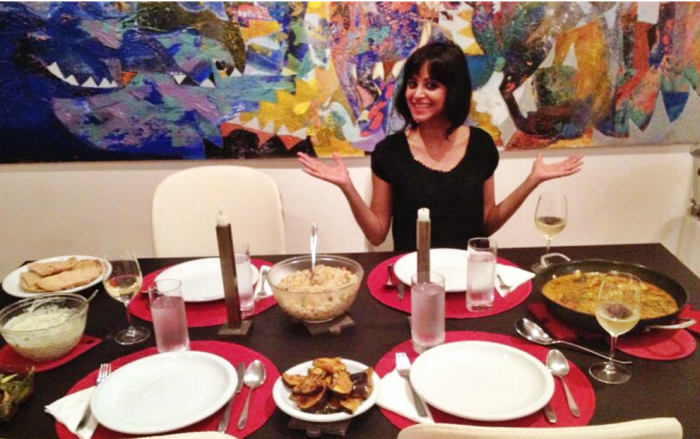“I emotionally infuse the food with unbounded love, and a prayer to heal and nourish the bodies it will go into.” ~ Mother
~
They say that food cooked by one’s mother is incomparable to any other.
For me, this is especially true. My mother channels “Annapūrṇa”—the Indian Goddess of food and nourishment (the name literally means “filled with or possessed of food”) in the kitchen effortlessly. Her mother—my grandmother—was a level higher; she was the Goddess Annapūrṇa herself, I believe.
To this day I am still flabbergasted by the fact that she could create heavenly scrumptious and nutritious concoctions out of scraps and peels of various gourds, and many other vegetables. I could not believe the way my palate would come alive from ecstasy when I ate her food; it was especially magical, knowing that she had made it from the “scraps” and left-over peels (because in an Indian kitchen, we waste/throw nothing if we can help it).
Almost 20 years ago when I was in college, my friends from other states who stayed in hostels or rented apartments in New Delhi would often come to my place—only so they could eat my mother’s food. A decade and a half before that, it was me/us who would go to West Bengal every summer for three months to see my grandmother, but mostly to eat her food!
Today, I get texts from close friends like these:
“I plan to abduct you one day and bring you to France just so you can feed me your food.”
“I wish I could get on a flight, eat your food, and fly back. Yeah, I’d fly 10 hours just to eat your food!”
This last line above took a lot for me to go public with, but I wanted to show how we are bound (inter-generationally and inter-culturally) by this invisible thread of food, and of love—despite geographical separation/complications.
So what’s the trick to this kind of food? I would often ask my mother why and how her food could be this drool-worthy even though they were just regular, simple, and quick recipes (trust me, there were a lot of extremely elaborate ones too, but we’re not going there yet). It wasn’t until I was in my mid-to-late-20s when I was getting really obsessed with cooking, that she told me this:
“While I am cooking, as I put one ingredient after the other, I emotionally infuse it with unbounded love, and a prayer to heal and nourish the bodies it will go into. I saw how your grandmother would bathe before dawn, do her morning yoga and meditation/prayers for two hours, and then enter the kitchen with a certain intention before preparing all the meals for the day. The love with which she did this ritually, every day of her life, taught me how sacred the whole process around food and eating was.”
Hearing this, something inside me shifted in a huge way. I do remember this as I trace my early childhood memories. I remember my grandmother draped in classic white cotton Bengali sari…her thick, wet, and luscious dark hair hanging below her hips, sitting on the kitchen floor—her foot firmly anchored on the dao, slicing very many vegetables and announcing, “Take your slippers off before entering!” when I would get out of the pond in her house and come darting into the kitchen for a snack. Before entering temples in India, people have to take their footwear off. I see now, that for her, the kitchen was no less than a temple; and the food prepared therein, no less than nourishment from Mother Gaia herself.
I have added my own imagination and rituals to these psycho-emotional processes my ancestors practiced when I am in my kitchen. It might look on the outside that I am just standing in my kitchen between many vegetables and spices, and cooking. I will let you all in on my trick as to what is happening internally—between myself and every ingredient that I interact with.
If it’s the tomatoes, for example, in my mind as I am washing a tomato, I put in the energy of a caress almost, and I imagine its seed, the loving hands that got down and dirty into the soil, and with the manure, tended to it with proper water, sunlight, and care, and plucked it when ripe. Its journey from the seed that it was, to its full potential that it is in my hands at that moment.
I am not only imagining its story and journey, but I am also feeling into it and thanking it for arriving in my hands in the here and now; I am full of gratitude and have goosebumps from connecting to it. My mind and my senses are nowhere but in full presence with the tomato—its lovely fragrance, its deep red colour, its soft and pulpy texture, and its citrus-sweet taste…it’s akin to open-eye meditation.
Same goes for the oils, the spices, and condiments, all the base and main roots and vegetables, and the herbs I am using. Every single one of them, I interact with, feel into, and thank for being here to nourish me and my beloveds. My soul extends through my body and into the ingredients. My food is full with a recognition and acknowledgment of the story of the ingredients and the invisible people, and mama Tierra, and the aroma thereafter overflows into gratitude of the highest kind. My body is a sacred vehicle, my kitchen, a temple where everything that nourishes me comes into play. That is my “trick!”
For the first recipe, I thought of picking what a lot of people, including many vegans, call “boring” food: poor old tofu. This is one of my favourite breakfasts; incredibly quick, simple, and delicious!
I encourage you to try making it while thinking, or even practicing, all that I have said above!
Turmeric Tofu Scramble
(Serves two)
Ingredients
250 grams pedigree quality tofu, grated thinly
Organic coconut oil: 1/1.5 tablespoon
1 green chilli (easily available in Indian grocery stores), chopped
1 onion, diced
½ tsp Jakhya Cleome Viscosa seeds, or Asian Spiderflower; a good alternative is red mustard seeds
2 tomatoes, diced
Optional: a fistful of grated fresh coconut; if you cannot find this, dry/desiccated coconut
A few sprigs of fresh green coriander (cilantro)
1/3rd teaspoon turmeric
Salt as per taste
Method:
1. Heat the pan and pour 1/1.5 full tablespoon of coconut oil into it (remember, the trick to the scrumptiousness of this recipe is in the coconut oil, so make sure to use this oil only).
2. Put ½ tsp Jakhya seeds or red mustard seeds and let them pop (you’ll hear slight crackling sound) but don’t overheat or burn them; I’d say, give them 10-15 seconds in the hot oil, no more.
3. Add the chopped green chilli, and five seconds later, add the finely diced onion.
4. Add half the amount of total salt that you will use now, and mix it up in the onions (adding some salt at this stage makes the onions cook faster, and helps conserve the gas/electricity).
5. Sauté the onions until they turn a light shade of golden brown, and then add the finely diced tomatoes.
6. Sprinkle 1/3rd tsp turmeric over it and mix it up well. Let it cook for 3-4 minutes; you want to cook the tomatoes but to the point that they are still crunchy; do not let them turn mushy.
7. Add the grated tofu into the wok and turn it around gently to mix all the ingredients. Grating the tofu into thin strips allows it to absorb all the flavours/oil/juices much more deeply. Always grate tofu for maximum taste and flavour absorption!
8. After mixing all the ingredients for about a minute, turn off the gas. Sprinkle that fistful of grated coconut/or dry, desiccated coconut on top. If you’re unable to find coconut in any form, you can skip this part and it will still taste as good.
9. Add chopped green coriander leaves, et voilà—your super tasty, super healthy, and filling breakfast is ready!
Don’t forget the gratitude prayer (yes, it can be silent and internal, and you don’t have to close your eyes!)
~













Read 15 comments and reply